System Thinking, Strategic Management, and Complexity: A Report
VerifiedAdded on 2023/01/18
|13
|4060
|57
Report
AI Summary
This report delves into the concept of system thinking within the context of management and strategic planning. It begins by defining system thinking as a holistic approach that emphasizes the interconnectedness of various elements within a system, contrasting it with traditional, individual-component-focused methods. The report then explores different strategic thinking approaches, highlighting their evolution and importance in adapting to dynamic business environments. It examines the elements of system thinking (elements, interconnections, and function) and their practical applications. Furthermore, the report discusses complexity perspectives, including complex adaptive systems, and how they can be modeled to understand the intricate relationships within an organization. The report also analyzes the practice perspective, which is concerned with the undertaking of strategy and emphasizes the importance of assessing both micro and macro environmental factors. The report concludes by underscoring the significance of integrating system thinking into strategic management to foster a comprehensive understanding of organizational dynamics, improve decision-making, and enhance adaptability in the face of complexity.
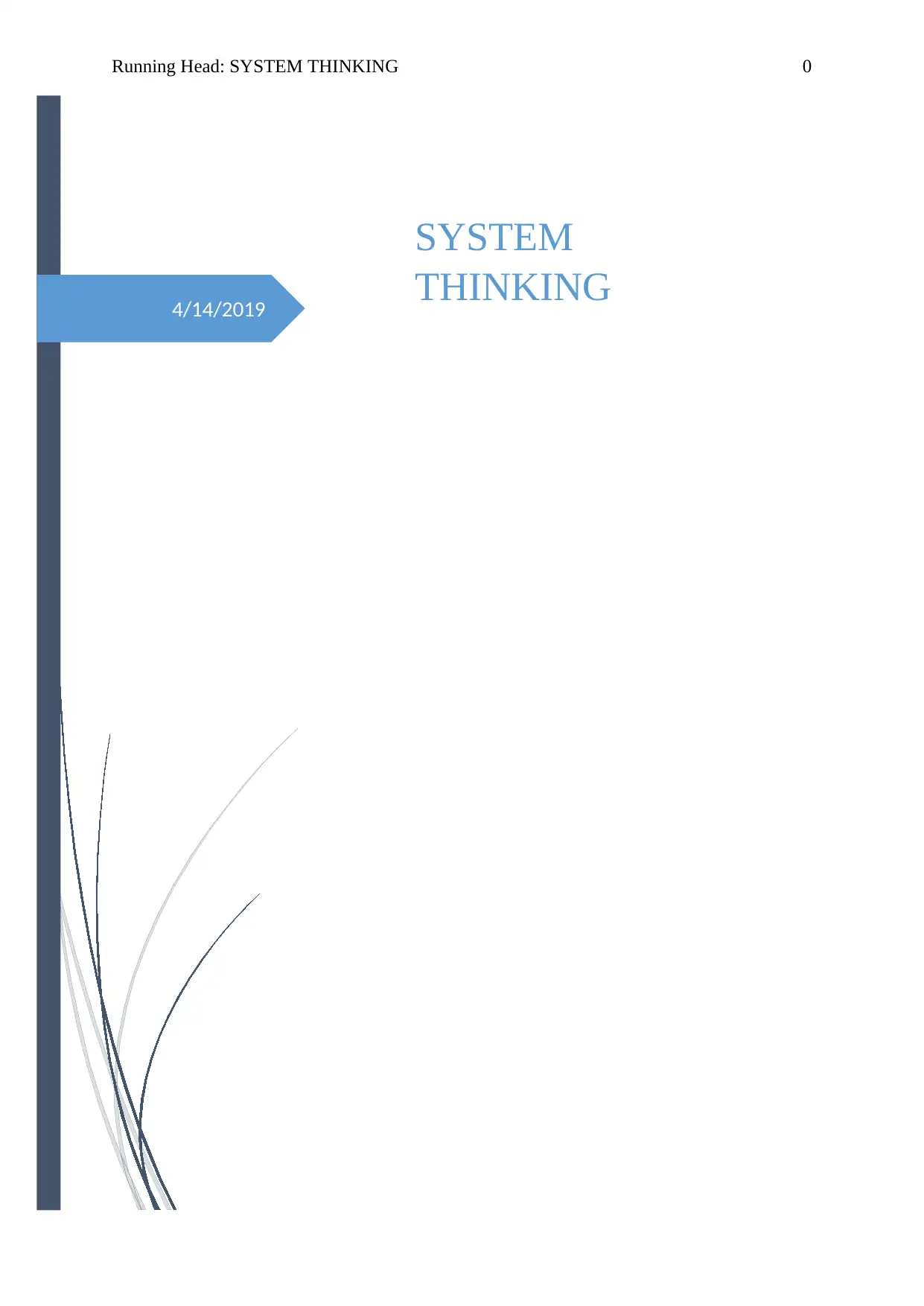
4/14/2019
Running Head: SYSTEM THINKING 0
SYSTEM
THINKING
Running Head: SYSTEM THINKING 0
SYSTEM
THINKING
Paraphrase This Document
Need a fresh take? Get an instant paraphrase of this document with our AI Paraphraser
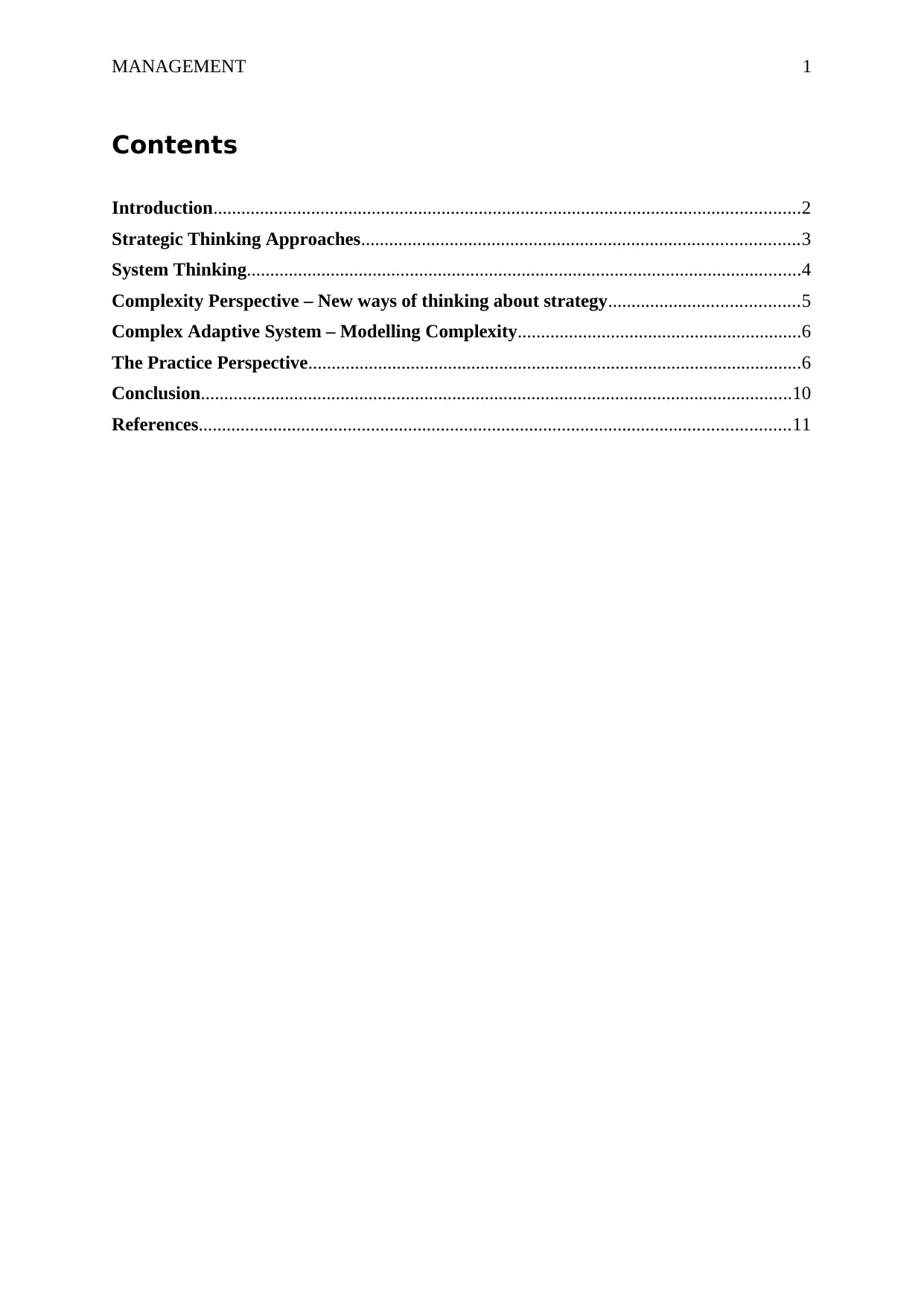
MANAGEMENT 1
Contents
Introduction..............................................................................................................................2
Strategic Thinking Approaches..............................................................................................3
System Thinking.......................................................................................................................4
Complexity Perspective – New ways of thinking about strategy.........................................5
Complex Adaptive System – Modelling Complexity.............................................................6
The Practice Perspective..........................................................................................................6
Conclusion...............................................................................................................................10
References...............................................................................................................................11
Contents
Introduction..............................................................................................................................2
Strategic Thinking Approaches..............................................................................................3
System Thinking.......................................................................................................................4
Complexity Perspective – New ways of thinking about strategy.........................................5
Complex Adaptive System – Modelling Complexity.............................................................6
The Practice Perspective..........................................................................................................6
Conclusion...............................................................................................................................10
References...............................................................................................................................11
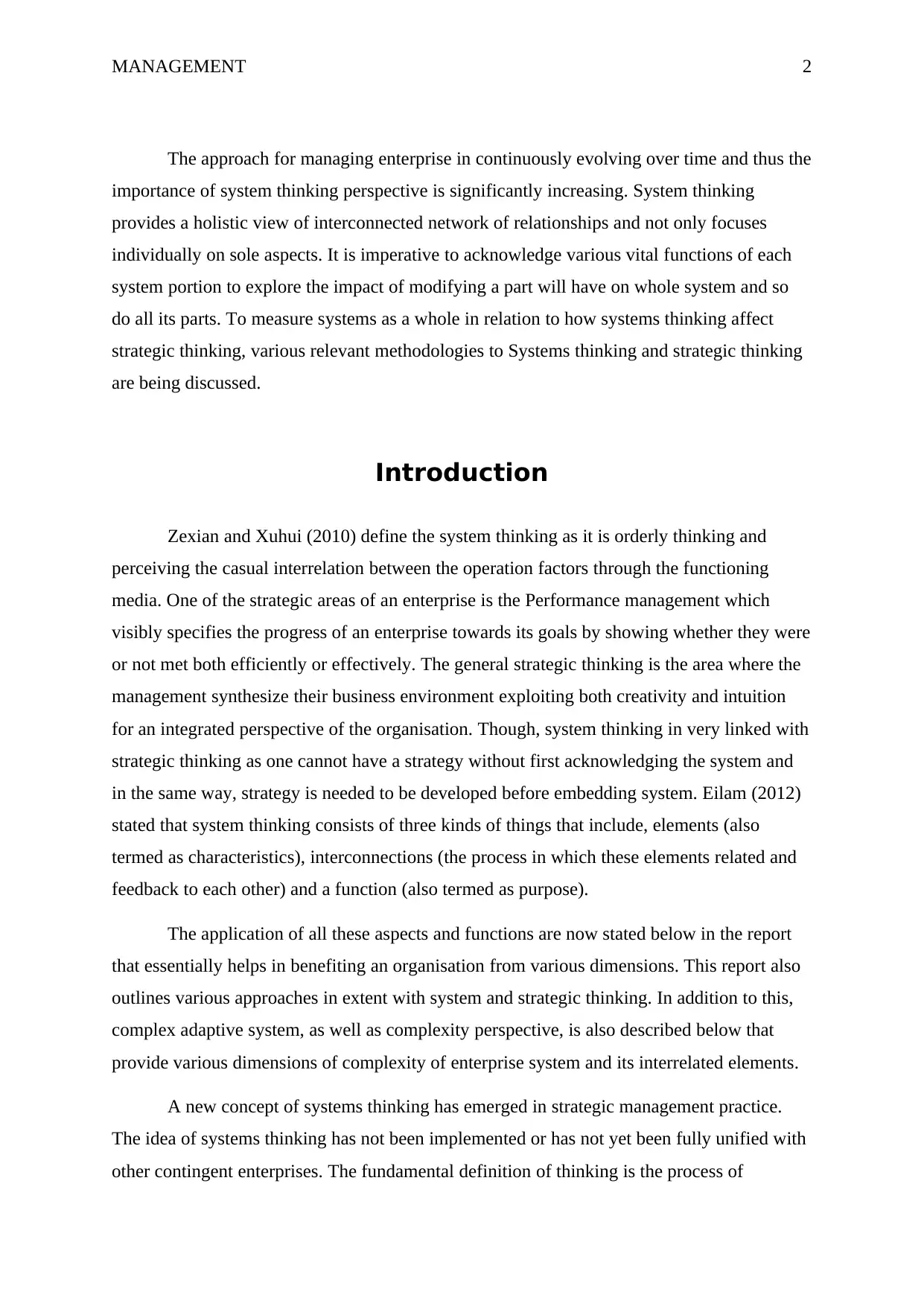
MANAGEMENT 2
The approach for managing enterprise in continuously evolving over time and thus the
importance of system thinking perspective is significantly increasing. System thinking
provides a holistic view of interconnected network of relationships and not only focuses
individually on sole aspects. It is imperative to acknowledge various vital functions of each
system portion to explore the impact of modifying a part will have on whole system and so
do all its parts. To measure systems as a whole in relation to how systems thinking affect
strategic thinking, various relevant methodologies to Systems thinking and strategic thinking
are being discussed.
Introduction
Zexian and Xuhui (2010) define the system thinking as it is orderly thinking and
perceiving the casual interrelation between the operation factors through the functioning
media. One of the strategic areas of an enterprise is the Performance management which
visibly specifies the progress of an enterprise towards its goals by showing whether they were
or not met both efficiently or effectively. The general strategic thinking is the area where the
management synthesize their business environment exploiting both creativity and intuition
for an integrated perspective of the organisation. Though, system thinking in very linked with
strategic thinking as one cannot have a strategy without first acknowledging the system and
in the same way, strategy is needed to be developed before embedding system. Eilam (2012)
stated that system thinking consists of three kinds of things that include, elements (also
termed as characteristics), interconnections (the process in which these elements related and
feedback to each other) and a function (also termed as purpose).
The application of all these aspects and functions are now stated below in the report
that essentially helps in benefiting an organisation from various dimensions. This report also
outlines various approaches in extent with system and strategic thinking. In addition to this,
complex adaptive system, as well as complexity perspective, is also described below that
provide various dimensions of complexity of enterprise system and its interrelated elements.
A new concept of systems thinking has emerged in strategic management practice.
The idea of systems thinking has not been implemented or has not yet been fully unified with
other contingent enterprises. The fundamental definition of thinking is the process of
The approach for managing enterprise in continuously evolving over time and thus the
importance of system thinking perspective is significantly increasing. System thinking
provides a holistic view of interconnected network of relationships and not only focuses
individually on sole aspects. It is imperative to acknowledge various vital functions of each
system portion to explore the impact of modifying a part will have on whole system and so
do all its parts. To measure systems as a whole in relation to how systems thinking affect
strategic thinking, various relevant methodologies to Systems thinking and strategic thinking
are being discussed.
Introduction
Zexian and Xuhui (2010) define the system thinking as it is orderly thinking and
perceiving the casual interrelation between the operation factors through the functioning
media. One of the strategic areas of an enterprise is the Performance management which
visibly specifies the progress of an enterprise towards its goals by showing whether they were
or not met both efficiently or effectively. The general strategic thinking is the area where the
management synthesize their business environment exploiting both creativity and intuition
for an integrated perspective of the organisation. Though, system thinking in very linked with
strategic thinking as one cannot have a strategy without first acknowledging the system and
in the same way, strategy is needed to be developed before embedding system. Eilam (2012)
stated that system thinking consists of three kinds of things that include, elements (also
termed as characteristics), interconnections (the process in which these elements related and
feedback to each other) and a function (also termed as purpose).
The application of all these aspects and functions are now stated below in the report
that essentially helps in benefiting an organisation from various dimensions. This report also
outlines various approaches in extent with system and strategic thinking. In addition to this,
complex adaptive system, as well as complexity perspective, is also described below that
provide various dimensions of complexity of enterprise system and its interrelated elements.
A new concept of systems thinking has emerged in strategic management practice.
The idea of systems thinking has not been implemented or has not yet been fully unified with
other contingent enterprises. The fundamental definition of thinking is the process of
⊘ This is a preview!⊘
Do you want full access?
Subscribe today to unlock all pages.

Trusted by 1+ million students worldwide
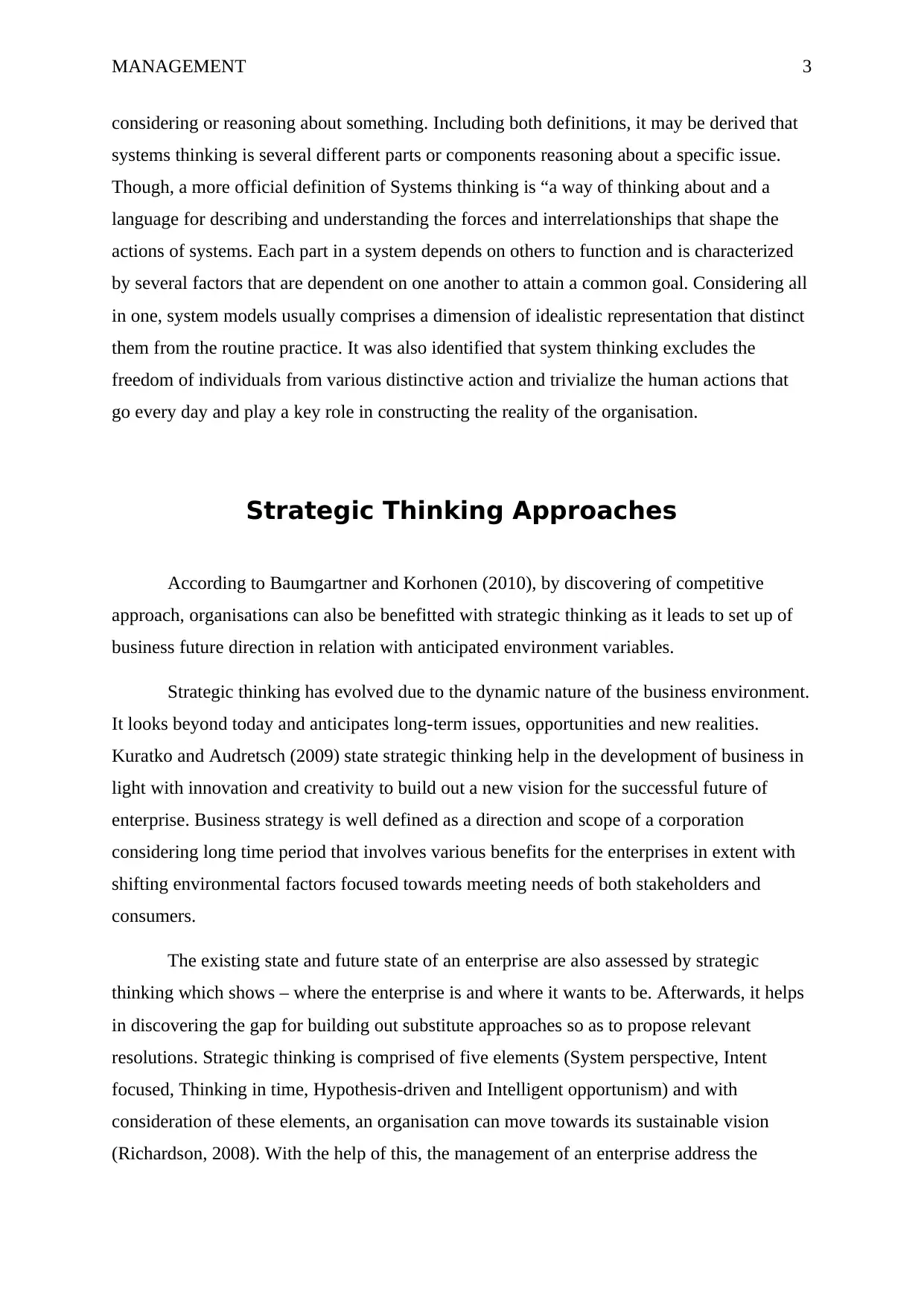
MANAGEMENT 3
considering or reasoning about something. Including both definitions, it may be derived that
systems thinking is several different parts or components reasoning about a specific issue.
Though, a more official definition of Systems thinking is “a way of thinking about and a
language for describing and understanding the forces and interrelationships that shape the
actions of systems. Each part in a system depends on others to function and is characterized
by several factors that are dependent on one another to attain a common goal. Considering all
in one, system models usually comprises a dimension of idealistic representation that distinct
them from the routine practice. It was also identified that system thinking excludes the
freedom of individuals from various distinctive action and trivialize the human actions that
go every day and play a key role in constructing the reality of the organisation.
Strategic Thinking Approaches
According to Baumgartner and Korhonen (2010), by discovering of competitive
approach, organisations can also be benefitted with strategic thinking as it leads to set up of
business future direction in relation with anticipated environment variables.
Strategic thinking has evolved due to the dynamic nature of the business environment.
It looks beyond today and anticipates long-term issues, opportunities and new realities.
Kuratko and Audretsch (2009) state strategic thinking help in the development of business in
light with innovation and creativity to build out a new vision for the successful future of
enterprise. Business strategy is well defined as a direction and scope of a corporation
considering long time period that involves various benefits for the enterprises in extent with
shifting environmental factors focused towards meeting needs of both stakeholders and
consumers.
The existing state and future state of an enterprise are also assessed by strategic
thinking which shows – where the enterprise is and where it wants to be. Afterwards, it helps
in discovering the gap for building out substitute approaches so as to propose relevant
resolutions. Strategic thinking is comprised of five elements (System perspective, Intent
focused, Thinking in time, Hypothesis-driven and Intelligent opportunism) and with
consideration of these elements, an organisation can move towards its sustainable vision
(Richardson, 2008). With the help of this, the management of an enterprise address the
considering or reasoning about something. Including both definitions, it may be derived that
systems thinking is several different parts or components reasoning about a specific issue.
Though, a more official definition of Systems thinking is “a way of thinking about and a
language for describing and understanding the forces and interrelationships that shape the
actions of systems. Each part in a system depends on others to function and is characterized
by several factors that are dependent on one another to attain a common goal. Considering all
in one, system models usually comprises a dimension of idealistic representation that distinct
them from the routine practice. It was also identified that system thinking excludes the
freedom of individuals from various distinctive action and trivialize the human actions that
go every day and play a key role in constructing the reality of the organisation.
Strategic Thinking Approaches
According to Baumgartner and Korhonen (2010), by discovering of competitive
approach, organisations can also be benefitted with strategic thinking as it leads to set up of
business future direction in relation with anticipated environment variables.
Strategic thinking has evolved due to the dynamic nature of the business environment.
It looks beyond today and anticipates long-term issues, opportunities and new realities.
Kuratko and Audretsch (2009) state strategic thinking help in the development of business in
light with innovation and creativity to build out a new vision for the successful future of
enterprise. Business strategy is well defined as a direction and scope of a corporation
considering long time period that involves various benefits for the enterprises in extent with
shifting environmental factors focused towards meeting needs of both stakeholders and
consumers.
The existing state and future state of an enterprise are also assessed by strategic
thinking which shows – where the enterprise is and where it wants to be. Afterwards, it helps
in discovering the gap for building out substitute approaches so as to propose relevant
resolutions. Strategic thinking is comprised of five elements (System perspective, Intent
focused, Thinking in time, Hypothesis-driven and Intelligent opportunism) and with
consideration of these elements, an organisation can move towards its sustainable vision
(Richardson, 2008). With the help of this, the management of an enterprise address the
Paraphrase This Document
Need a fresh take? Get an instant paraphrase of this document with our AI Paraphraser
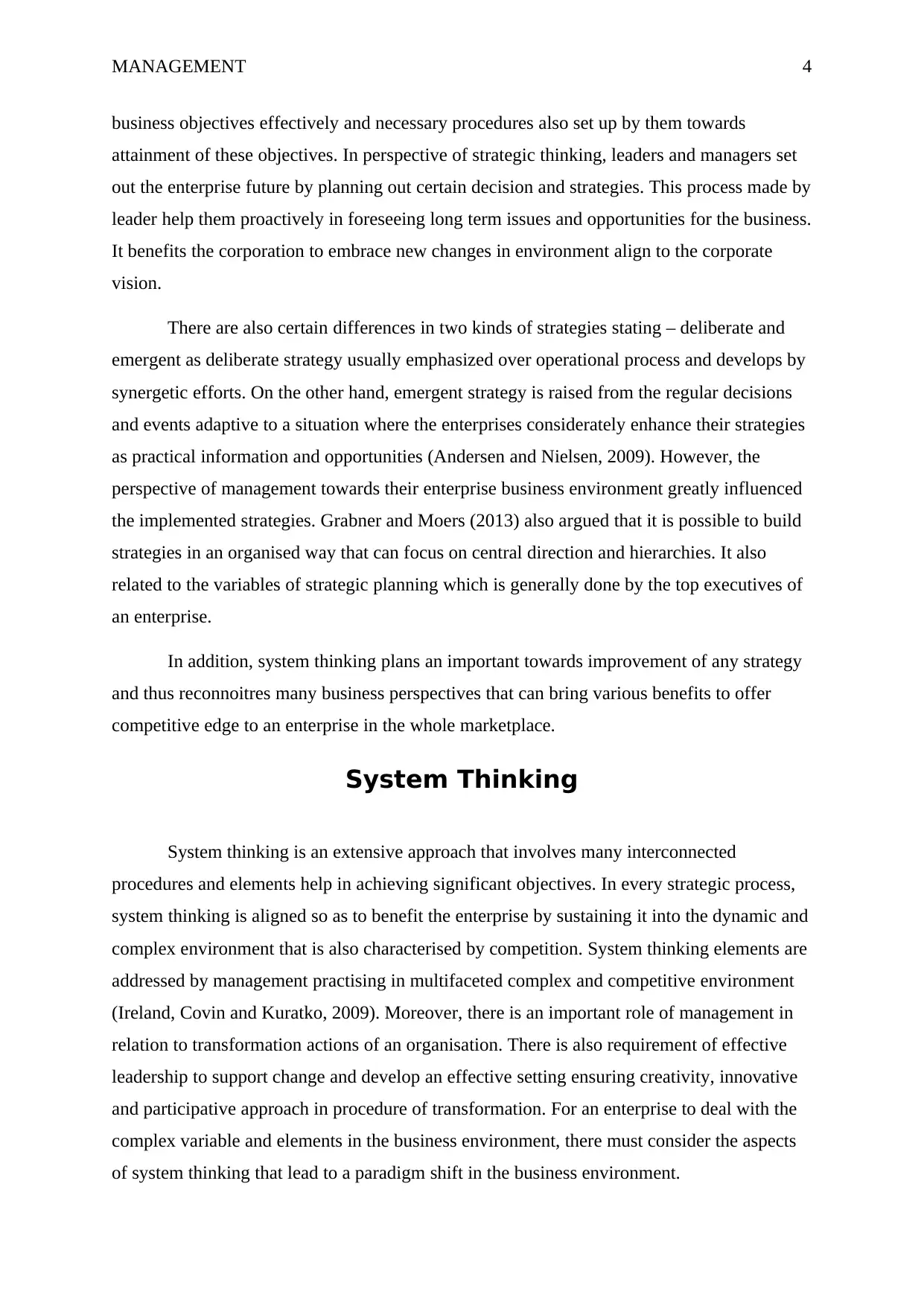
MANAGEMENT 4
business objectives effectively and necessary procedures also set up by them towards
attainment of these objectives. In perspective of strategic thinking, leaders and managers set
out the enterprise future by planning out certain decision and strategies. This process made by
leader help them proactively in foreseeing long term issues and opportunities for the business.
It benefits the corporation to embrace new changes in environment align to the corporate
vision.
There are also certain differences in two kinds of strategies stating – deliberate and
emergent as deliberate strategy usually emphasized over operational process and develops by
synergetic efforts. On the other hand, emergent strategy is raised from the regular decisions
and events adaptive to a situation where the enterprises considerately enhance their strategies
as practical information and opportunities (Andersen and Nielsen, 2009). However, the
perspective of management towards their enterprise business environment greatly influenced
the implemented strategies. Grabner and Moers (2013) also argued that it is possible to build
strategies in an organised way that can focus on central direction and hierarchies. It also
related to the variables of strategic planning which is generally done by the top executives of
an enterprise.
In addition, system thinking plans an important towards improvement of any strategy
and thus reconnoitres many business perspectives that can bring various benefits to offer
competitive edge to an enterprise in the whole marketplace.
System Thinking
System thinking is an extensive approach that involves many interconnected
procedures and elements help in achieving significant objectives. In every strategic process,
system thinking is aligned so as to benefit the enterprise by sustaining it into the dynamic and
complex environment that is also characterised by competition. System thinking elements are
addressed by management practising in multifaceted complex and competitive environment
(Ireland, Covin and Kuratko, 2009). Moreover, there is an important role of management in
relation to transformation actions of an organisation. There is also requirement of effective
leadership to support change and develop an effective setting ensuring creativity, innovative
and participative approach in procedure of transformation. For an enterprise to deal with the
complex variable and elements in the business environment, there must consider the aspects
of system thinking that lead to a paradigm shift in the business environment.
business objectives effectively and necessary procedures also set up by them towards
attainment of these objectives. In perspective of strategic thinking, leaders and managers set
out the enterprise future by planning out certain decision and strategies. This process made by
leader help them proactively in foreseeing long term issues and opportunities for the business.
It benefits the corporation to embrace new changes in environment align to the corporate
vision.
There are also certain differences in two kinds of strategies stating – deliberate and
emergent as deliberate strategy usually emphasized over operational process and develops by
synergetic efforts. On the other hand, emergent strategy is raised from the regular decisions
and events adaptive to a situation where the enterprises considerately enhance their strategies
as practical information and opportunities (Andersen and Nielsen, 2009). However, the
perspective of management towards their enterprise business environment greatly influenced
the implemented strategies. Grabner and Moers (2013) also argued that it is possible to build
strategies in an organised way that can focus on central direction and hierarchies. It also
related to the variables of strategic planning which is generally done by the top executives of
an enterprise.
In addition, system thinking plans an important towards improvement of any strategy
and thus reconnoitres many business perspectives that can bring various benefits to offer
competitive edge to an enterprise in the whole marketplace.
System Thinking
System thinking is an extensive approach that involves many interconnected
procedures and elements help in achieving significant objectives. In every strategic process,
system thinking is aligned so as to benefit the enterprise by sustaining it into the dynamic and
complex environment that is also characterised by competition. System thinking elements are
addressed by management practising in multifaceted complex and competitive environment
(Ireland, Covin and Kuratko, 2009). Moreover, there is an important role of management in
relation to transformation actions of an organisation. There is also requirement of effective
leadership to support change and develop an effective setting ensuring creativity, innovative
and participative approach in procedure of transformation. For an enterprise to deal with the
complex variable and elements in the business environment, there must consider the aspects
of system thinking that lead to a paradigm shift in the business environment.
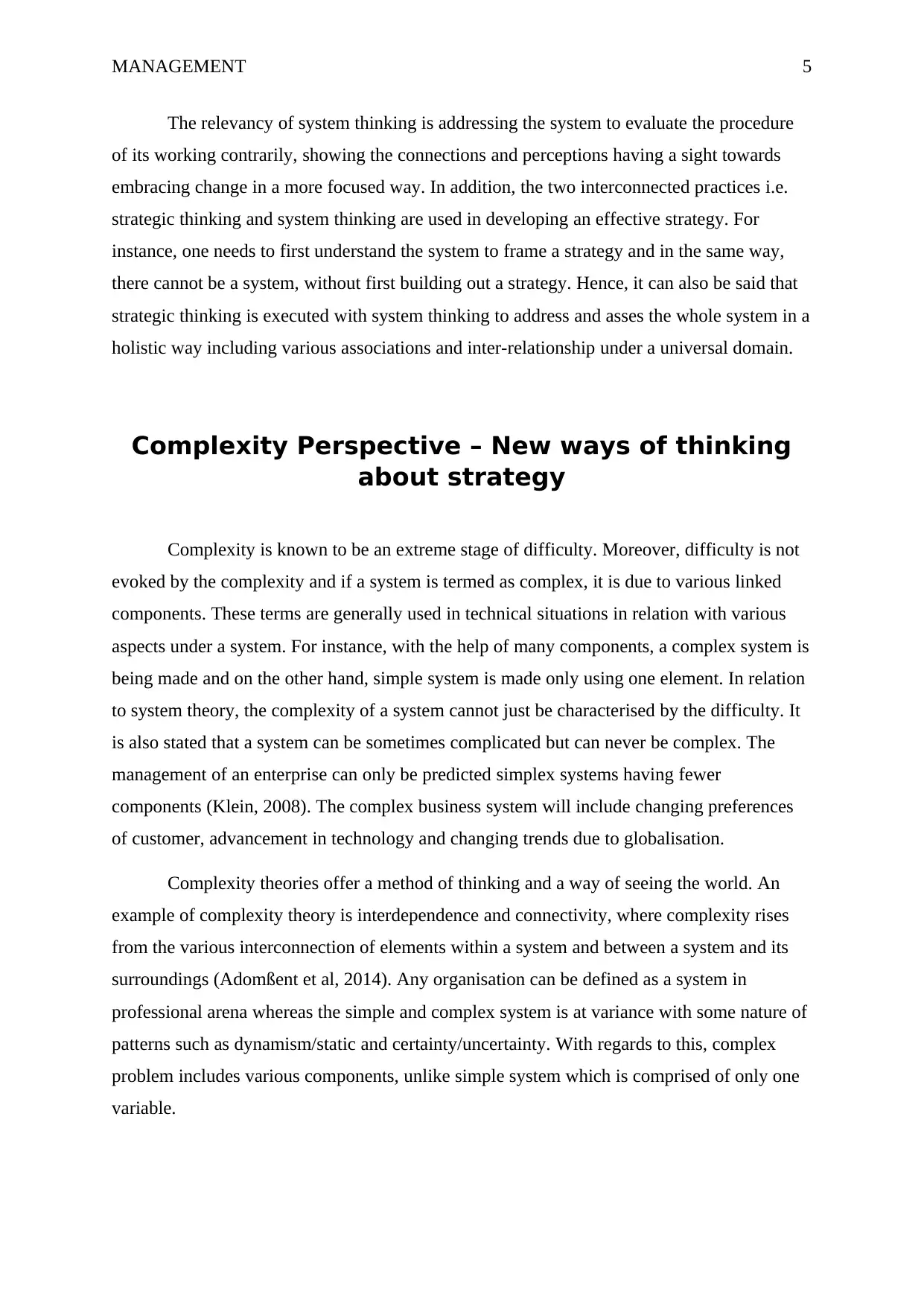
MANAGEMENT 5
The relevancy of system thinking is addressing the system to evaluate the procedure
of its working contrarily, showing the connections and perceptions having a sight towards
embracing change in a more focused way. In addition, the two interconnected practices i.e.
strategic thinking and system thinking are used in developing an effective strategy. For
instance, one needs to first understand the system to frame a strategy and in the same way,
there cannot be a system, without first building out a strategy. Hence, it can also be said that
strategic thinking is executed with system thinking to address and asses the whole system in a
holistic way including various associations and inter-relationship under a universal domain.
Complexity Perspective – New ways of thinking
about strategy
Complexity is known to be an extreme stage of difficulty. Moreover, difficulty is not
evoked by the complexity and if a system is termed as complex, it is due to various linked
components. These terms are generally used in technical situations in relation with various
aspects under a system. For instance, with the help of many components, a complex system is
being made and on the other hand, simple system is made only using one element. In relation
to system theory, the complexity of a system cannot just be characterised by the difficulty. It
is also stated that a system can be sometimes complicated but can never be complex. The
management of an enterprise can only be predicted simplex systems having fewer
components (Klein, 2008). The complex business system will include changing preferences
of customer, advancement in technology and changing trends due to globalisation.
Complexity theories offer a method of thinking and a way of seeing the world. An
example of complexity theory is interdependence and connectivity, where complexity rises
from the various interconnection of elements within a system and between a system and its
surroundings (Adomßent et al, 2014). Any organisation can be defined as a system in
professional arena whereas the simple and complex system is at variance with some nature of
patterns such as dynamism/static and certainty/uncertainty. With regards to this, complex
problem includes various components, unlike simple system which is comprised of only one
variable.
The relevancy of system thinking is addressing the system to evaluate the procedure
of its working contrarily, showing the connections and perceptions having a sight towards
embracing change in a more focused way. In addition, the two interconnected practices i.e.
strategic thinking and system thinking are used in developing an effective strategy. For
instance, one needs to first understand the system to frame a strategy and in the same way,
there cannot be a system, without first building out a strategy. Hence, it can also be said that
strategic thinking is executed with system thinking to address and asses the whole system in a
holistic way including various associations and inter-relationship under a universal domain.
Complexity Perspective – New ways of thinking
about strategy
Complexity is known to be an extreme stage of difficulty. Moreover, difficulty is not
evoked by the complexity and if a system is termed as complex, it is due to various linked
components. These terms are generally used in technical situations in relation with various
aspects under a system. For instance, with the help of many components, a complex system is
being made and on the other hand, simple system is made only using one element. In relation
to system theory, the complexity of a system cannot just be characterised by the difficulty. It
is also stated that a system can be sometimes complicated but can never be complex. The
management of an enterprise can only be predicted simplex systems having fewer
components (Klein, 2008). The complex business system will include changing preferences
of customer, advancement in technology and changing trends due to globalisation.
Complexity theories offer a method of thinking and a way of seeing the world. An
example of complexity theory is interdependence and connectivity, where complexity rises
from the various interconnection of elements within a system and between a system and its
surroundings (Adomßent et al, 2014). Any organisation can be defined as a system in
professional arena whereas the simple and complex system is at variance with some nature of
patterns such as dynamism/static and certainty/uncertainty. With regards to this, complex
problem includes various components, unlike simple system which is comprised of only one
variable.
⊘ This is a preview!⊘
Do you want full access?
Subscribe today to unlock all pages.

Trusted by 1+ million students worldwide
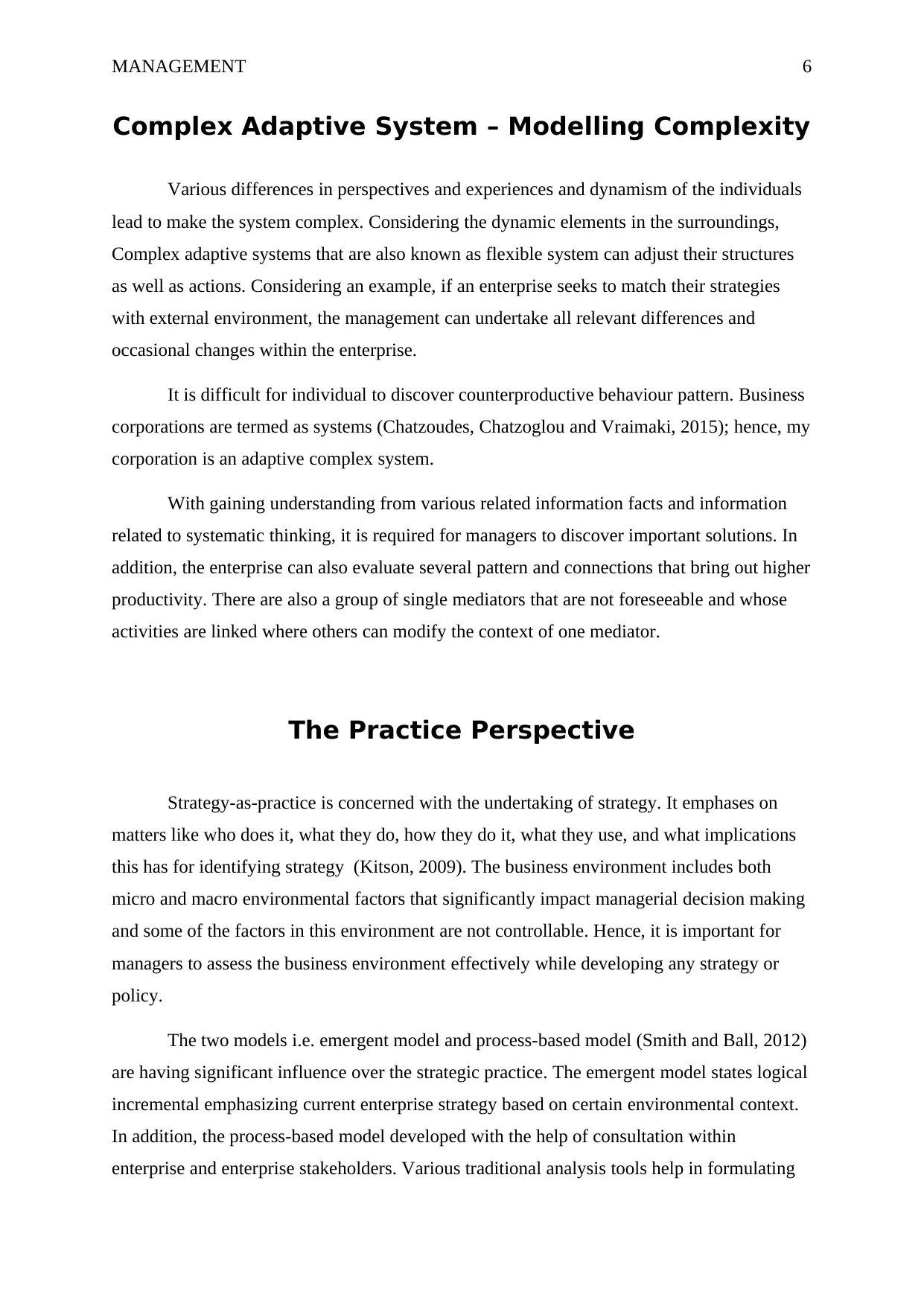
MANAGEMENT 6
Complex Adaptive System – Modelling Complexity
Various differences in perspectives and experiences and dynamism of the individuals
lead to make the system complex. Considering the dynamic elements in the surroundings,
Complex adaptive systems that are also known as flexible system can adjust their structures
as well as actions. Considering an example, if an enterprise seeks to match their strategies
with external environment, the management can undertake all relevant differences and
occasional changes within the enterprise.
It is difficult for individual to discover counterproductive behaviour pattern. Business
corporations are termed as systems (Chatzoudes, Chatzoglou and Vraimaki, 2015); hence, my
corporation is an adaptive complex system.
With gaining understanding from various related information facts and information
related to systematic thinking, it is required for managers to discover important solutions. In
addition, the enterprise can also evaluate several pattern and connections that bring out higher
productivity. There are also a group of single mediators that are not foreseeable and whose
activities are linked where others can modify the context of one mediator.
The Practice Perspective
Strategy-as-practice is concerned with the undertaking of strategy. It emphases on
matters like who does it, what they do, how they do it, what they use, and what implications
this has for identifying strategy (Kitson, 2009). The business environment includes both
micro and macro environmental factors that significantly impact managerial decision making
and some of the factors in this environment are not controllable. Hence, it is important for
managers to assess the business environment effectively while developing any strategy or
policy.
The two models i.e. emergent model and process-based model (Smith and Ball, 2012)
are having significant influence over the strategic practice. The emergent model states logical
incremental emphasizing current enterprise strategy based on certain environmental context.
In addition, the process-based model developed with the help of consultation within
enterprise and enterprise stakeholders. Various traditional analysis tools help in formulating
Complex Adaptive System – Modelling Complexity
Various differences in perspectives and experiences and dynamism of the individuals
lead to make the system complex. Considering the dynamic elements in the surroundings,
Complex adaptive systems that are also known as flexible system can adjust their structures
as well as actions. Considering an example, if an enterprise seeks to match their strategies
with external environment, the management can undertake all relevant differences and
occasional changes within the enterprise.
It is difficult for individual to discover counterproductive behaviour pattern. Business
corporations are termed as systems (Chatzoudes, Chatzoglou and Vraimaki, 2015); hence, my
corporation is an adaptive complex system.
With gaining understanding from various related information facts and information
related to systematic thinking, it is required for managers to discover important solutions. In
addition, the enterprise can also evaluate several pattern and connections that bring out higher
productivity. There are also a group of single mediators that are not foreseeable and whose
activities are linked where others can modify the context of one mediator.
The Practice Perspective
Strategy-as-practice is concerned with the undertaking of strategy. It emphases on
matters like who does it, what they do, how they do it, what they use, and what implications
this has for identifying strategy (Kitson, 2009). The business environment includes both
micro and macro environmental factors that significantly impact managerial decision making
and some of the factors in this environment are not controllable. Hence, it is important for
managers to assess the business environment effectively while developing any strategy or
policy.
The two models i.e. emergent model and process-based model (Smith and Ball, 2012)
are having significant influence over the strategic practice. The emergent model states logical
incremental emphasizing current enterprise strategy based on certain environmental context.
In addition, the process-based model developed with the help of consultation within
enterprise and enterprise stakeholders. Various traditional analysis tools help in formulating
Paraphrase This Document
Need a fresh take? Get an instant paraphrase of this document with our AI Paraphraser
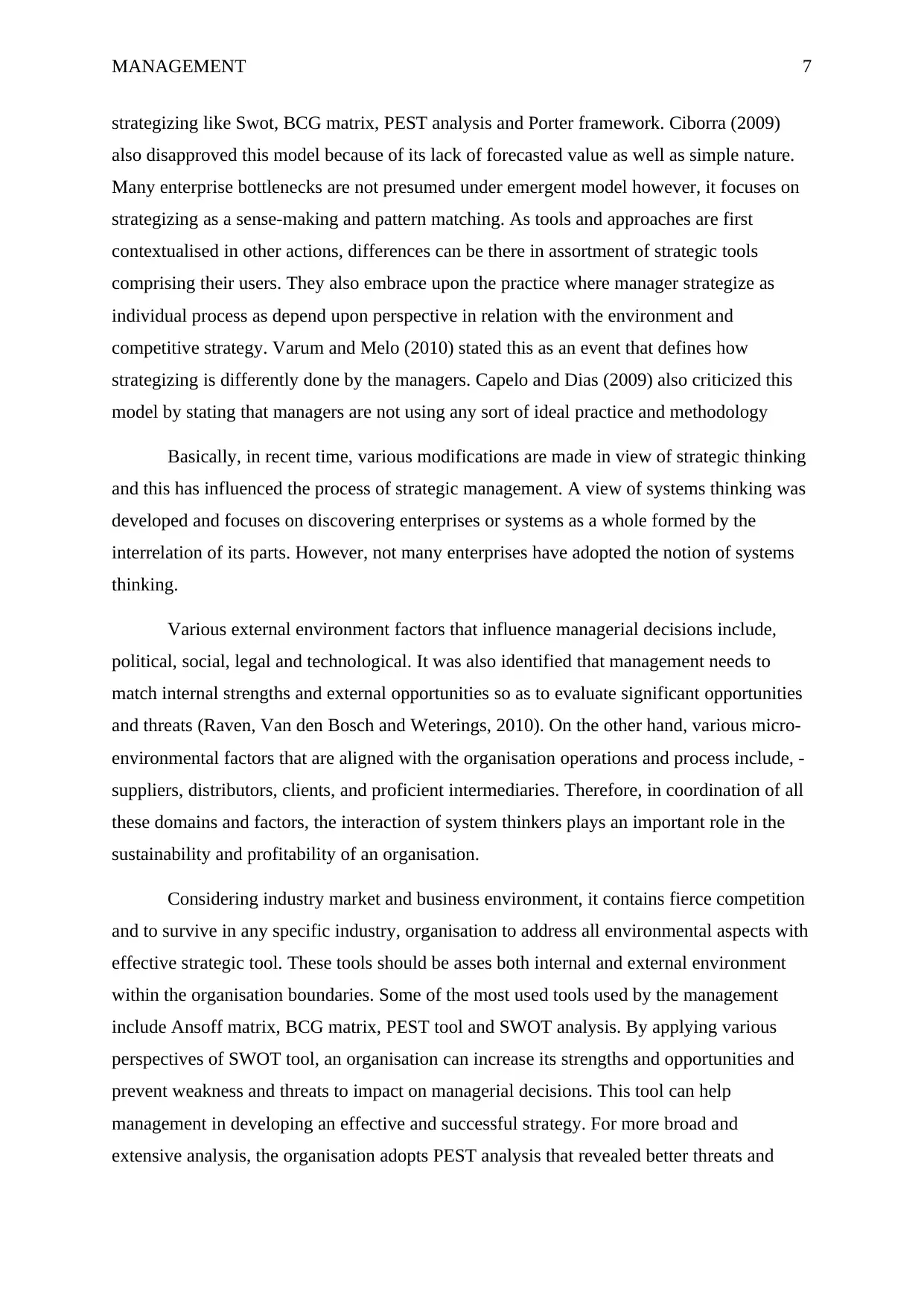
MANAGEMENT 7
strategizing like Swot, BCG matrix, PEST analysis and Porter framework. Ciborra (2009)
also disapproved this model because of its lack of forecasted value as well as simple nature.
Many enterprise bottlenecks are not presumed under emergent model however, it focuses on
strategizing as a sense-making and pattern matching. As tools and approaches are first
contextualised in other actions, differences can be there in assortment of strategic tools
comprising their users. They also embrace upon the practice where manager strategize as
individual process as depend upon perspective in relation with the environment and
competitive strategy. Varum and Melo (2010) stated this as an event that defines how
strategizing is differently done by the managers. Capelo and Dias (2009) also criticized this
model by stating that managers are not using any sort of ideal practice and methodology
Basically, in recent time, various modifications are made in view of strategic thinking
and this has influenced the process of strategic management. A view of systems thinking was
developed and focuses on discovering enterprises or systems as a whole formed by the
interrelation of its parts. However, not many enterprises have adopted the notion of systems
thinking.
Various external environment factors that influence managerial decisions include,
political, social, legal and technological. It was also identified that management needs to
match internal strengths and external opportunities so as to evaluate significant opportunities
and threats (Raven, Van den Bosch and Weterings, 2010). On the other hand, various micro-
environmental factors that are aligned with the organisation operations and process include, -
suppliers, distributors, clients, and proficient intermediaries. Therefore, in coordination of all
these domains and factors, the interaction of system thinkers plays an important role in the
sustainability and profitability of an organisation.
Considering industry market and business environment, it contains fierce competition
and to survive in any specific industry, organisation to address all environmental aspects with
effective strategic tool. These tools should be asses both internal and external environment
within the organisation boundaries. Some of the most used tools used by the management
include Ansoff matrix, BCG matrix, PEST tool and SWOT analysis. By applying various
perspectives of SWOT tool, an organisation can increase its strengths and opportunities and
prevent weakness and threats to impact on managerial decisions. This tool can help
management in developing an effective and successful strategy. For more broad and
extensive analysis, the organisation adopts PEST analysis that revealed better threats and
strategizing like Swot, BCG matrix, PEST analysis and Porter framework. Ciborra (2009)
also disapproved this model because of its lack of forecasted value as well as simple nature.
Many enterprise bottlenecks are not presumed under emergent model however, it focuses on
strategizing as a sense-making and pattern matching. As tools and approaches are first
contextualised in other actions, differences can be there in assortment of strategic tools
comprising their users. They also embrace upon the practice where manager strategize as
individual process as depend upon perspective in relation with the environment and
competitive strategy. Varum and Melo (2010) stated this as an event that defines how
strategizing is differently done by the managers. Capelo and Dias (2009) also criticized this
model by stating that managers are not using any sort of ideal practice and methodology
Basically, in recent time, various modifications are made in view of strategic thinking
and this has influenced the process of strategic management. A view of systems thinking was
developed and focuses on discovering enterprises or systems as a whole formed by the
interrelation of its parts. However, not many enterprises have adopted the notion of systems
thinking.
Various external environment factors that influence managerial decisions include,
political, social, legal and technological. It was also identified that management needs to
match internal strengths and external opportunities so as to evaluate significant opportunities
and threats (Raven, Van den Bosch and Weterings, 2010). On the other hand, various micro-
environmental factors that are aligned with the organisation operations and process include, -
suppliers, distributors, clients, and proficient intermediaries. Therefore, in coordination of all
these domains and factors, the interaction of system thinkers plays an important role in the
sustainability and profitability of an organisation.
Considering industry market and business environment, it contains fierce competition
and to survive in any specific industry, organisation to address all environmental aspects with
effective strategic tool. These tools should be asses both internal and external environment
within the organisation boundaries. Some of the most used tools used by the management
include Ansoff matrix, BCG matrix, PEST tool and SWOT analysis. By applying various
perspectives of SWOT tool, an organisation can increase its strengths and opportunities and
prevent weakness and threats to impact on managerial decisions. This tool can help
management in developing an effective and successful strategy. For more broad and
extensive analysis, the organisation adopts PEST analysis that revealed better threats and
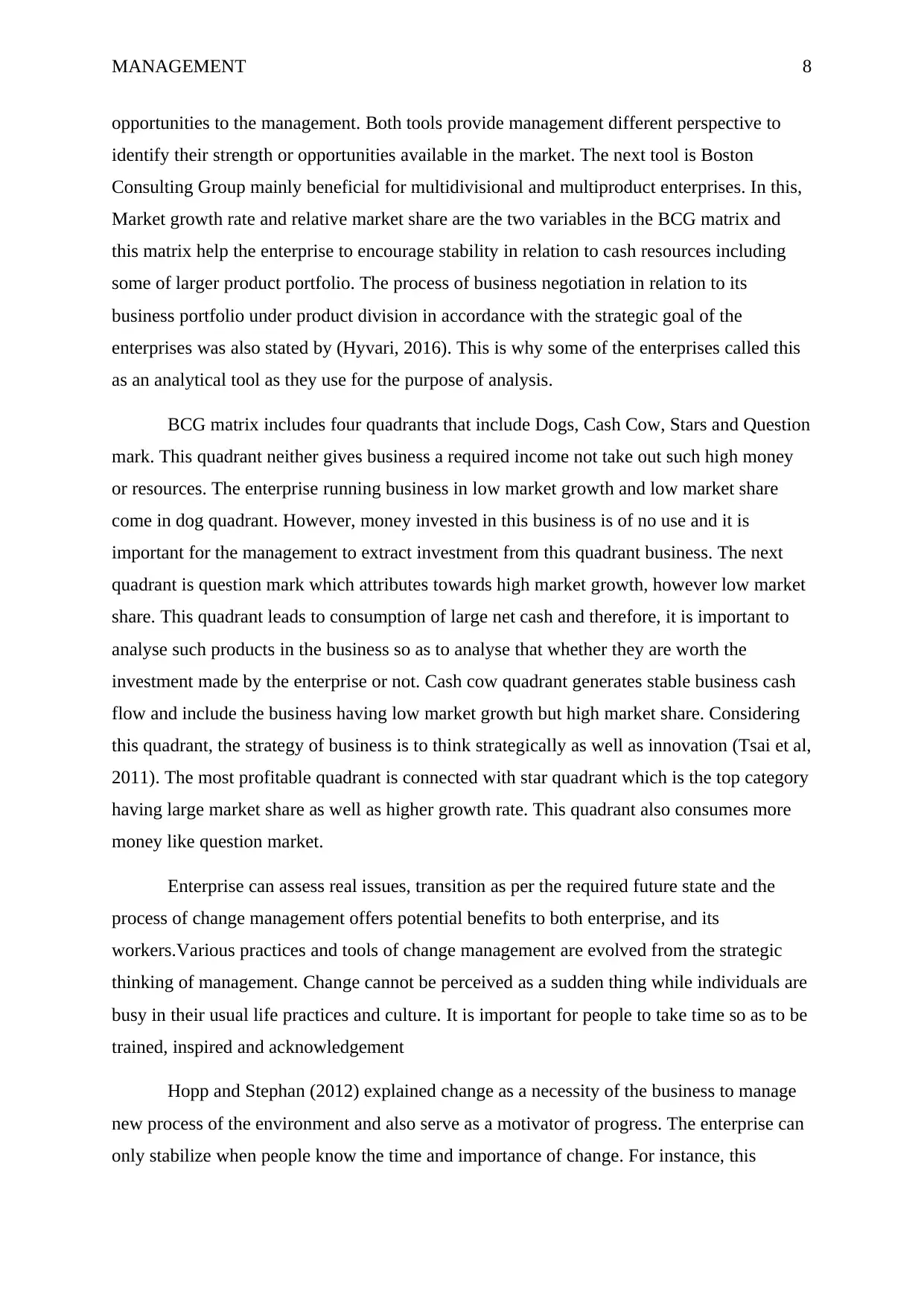
MANAGEMENT 8
opportunities to the management. Both tools provide management different perspective to
identify their strength or opportunities available in the market. The next tool is Boston
Consulting Group mainly beneficial for multidivisional and multiproduct enterprises. In this,
Market growth rate and relative market share are the two variables in the BCG matrix and
this matrix help the enterprise to encourage stability in relation to cash resources including
some of larger product portfolio. The process of business negotiation in relation to its
business portfolio under product division in accordance with the strategic goal of the
enterprises was also stated by (Hyvari, 2016). This is why some of the enterprises called this
as an analytical tool as they use for the purpose of analysis.
BCG matrix includes four quadrants that include Dogs, Cash Cow, Stars and Question
mark. This quadrant neither gives business a required income not take out such high money
or resources. The enterprise running business in low market growth and low market share
come in dog quadrant. However, money invested in this business is of no use and it is
important for the management to extract investment from this quadrant business. The next
quadrant is question mark which attributes towards high market growth, however low market
share. This quadrant leads to consumption of large net cash and therefore, it is important to
analyse such products in the business so as to analyse that whether they are worth the
investment made by the enterprise or not. Cash cow quadrant generates stable business cash
flow and include the business having low market growth but high market share. Considering
this quadrant, the strategy of business is to think strategically as well as innovation (Tsai et al,
2011). The most profitable quadrant is connected with star quadrant which is the top category
having large market share as well as higher growth rate. This quadrant also consumes more
money like question market.
Enterprise can assess real issues, transition as per the required future state and the
process of change management offers potential benefits to both enterprise, and its
workers.Various practices and tools of change management are evolved from the strategic
thinking of management. Change cannot be perceived as a sudden thing while individuals are
busy in their usual life practices and culture. It is important for people to take time so as to be
trained, inspired and acknowledgement
Hopp and Stephan (2012) explained change as a necessity of the business to manage
new process of the environment and also serve as a motivator of progress. The enterprise can
only stabilize when people know the time and importance of change. For instance, this
opportunities to the management. Both tools provide management different perspective to
identify their strength or opportunities available in the market. The next tool is Boston
Consulting Group mainly beneficial for multidivisional and multiproduct enterprises. In this,
Market growth rate and relative market share are the two variables in the BCG matrix and
this matrix help the enterprise to encourage stability in relation to cash resources including
some of larger product portfolio. The process of business negotiation in relation to its
business portfolio under product division in accordance with the strategic goal of the
enterprises was also stated by (Hyvari, 2016). This is why some of the enterprises called this
as an analytical tool as they use for the purpose of analysis.
BCG matrix includes four quadrants that include Dogs, Cash Cow, Stars and Question
mark. This quadrant neither gives business a required income not take out such high money
or resources. The enterprise running business in low market growth and low market share
come in dog quadrant. However, money invested in this business is of no use and it is
important for the management to extract investment from this quadrant business. The next
quadrant is question mark which attributes towards high market growth, however low market
share. This quadrant leads to consumption of large net cash and therefore, it is important to
analyse such products in the business so as to analyse that whether they are worth the
investment made by the enterprise or not. Cash cow quadrant generates stable business cash
flow and include the business having low market growth but high market share. Considering
this quadrant, the strategy of business is to think strategically as well as innovation (Tsai et al,
2011). The most profitable quadrant is connected with star quadrant which is the top category
having large market share as well as higher growth rate. This quadrant also consumes more
money like question market.
Enterprise can assess real issues, transition as per the required future state and the
process of change management offers potential benefits to both enterprise, and its
workers.Various practices and tools of change management are evolved from the strategic
thinking of management. Change cannot be perceived as a sudden thing while individuals are
busy in their usual life practices and culture. It is important for people to take time so as to be
trained, inspired and acknowledgement
Hopp and Stephan (2012) explained change as a necessity of the business to manage
new process of the environment and also serve as a motivator of progress. The enterprise can
only stabilize when people know the time and importance of change. For instance, this
⊘ This is a preview!⊘
Do you want full access?
Subscribe today to unlock all pages.

Trusted by 1+ million students worldwide
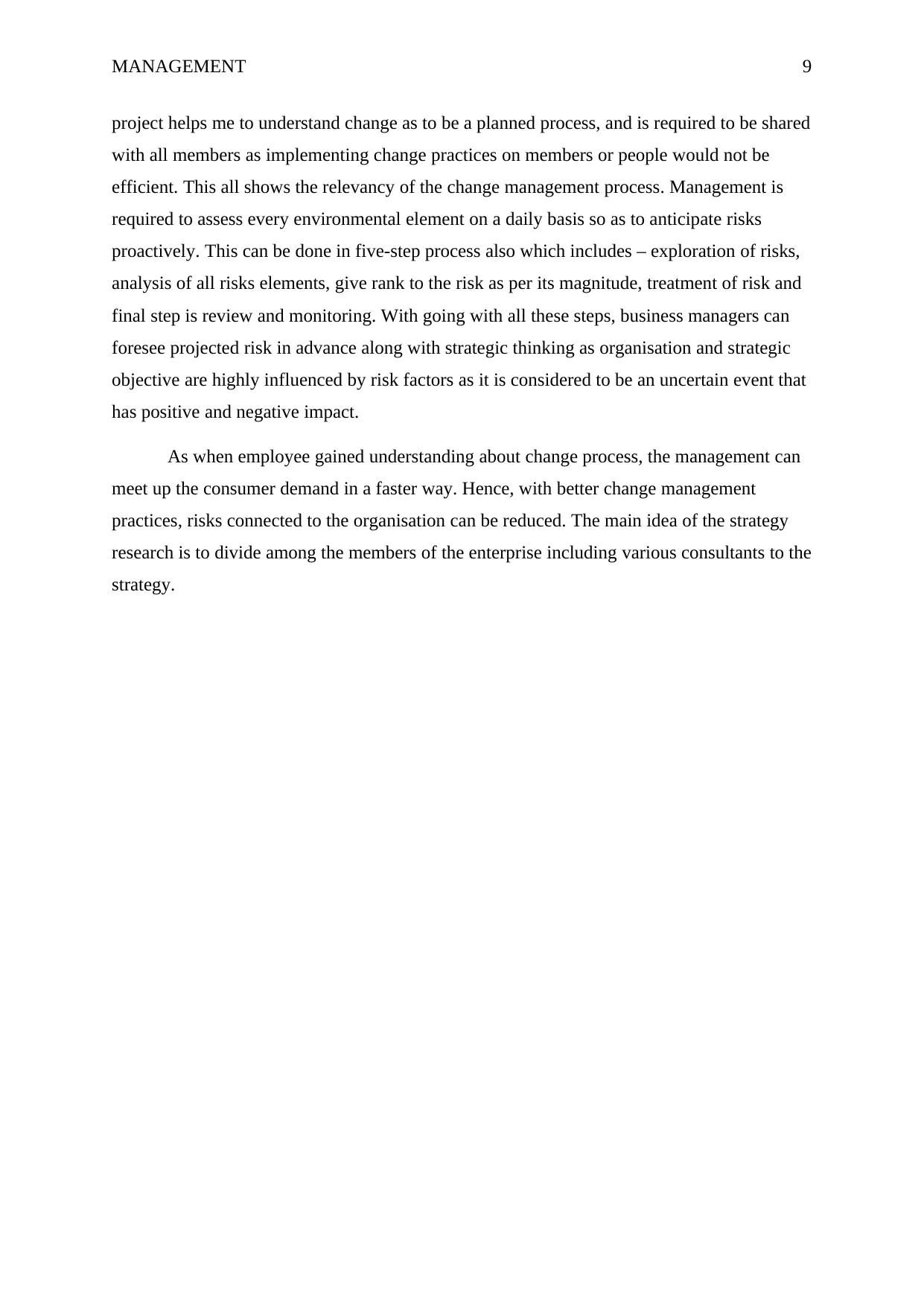
MANAGEMENT 9
project helps me to understand change as to be a planned process, and is required to be shared
with all members as implementing change practices on members or people would not be
efficient. This all shows the relevancy of the change management process. Management is
required to assess every environmental element on a daily basis so as to anticipate risks
proactively. This can be done in five-step process also which includes – exploration of risks,
analysis of all risks elements, give rank to the risk as per its magnitude, treatment of risk and
final step is review and monitoring. With going with all these steps, business managers can
foresee projected risk in advance along with strategic thinking as organisation and strategic
objective are highly influenced by risk factors as it is considered to be an uncertain event that
has positive and negative impact.
As when employee gained understanding about change process, the management can
meet up the consumer demand in a faster way. Hence, with better change management
practices, risks connected to the organisation can be reduced. The main idea of the strategy
research is to divide among the members of the enterprise including various consultants to the
strategy.
project helps me to understand change as to be a planned process, and is required to be shared
with all members as implementing change practices on members or people would not be
efficient. This all shows the relevancy of the change management process. Management is
required to assess every environmental element on a daily basis so as to anticipate risks
proactively. This can be done in five-step process also which includes – exploration of risks,
analysis of all risks elements, give rank to the risk as per its magnitude, treatment of risk and
final step is review and monitoring. With going with all these steps, business managers can
foresee projected risk in advance along with strategic thinking as organisation and strategic
objective are highly influenced by risk factors as it is considered to be an uncertain event that
has positive and negative impact.
As when employee gained understanding about change process, the management can
meet up the consumer demand in a faster way. Hence, with better change management
practices, risks connected to the organisation can be reduced. The main idea of the strategy
research is to divide among the members of the enterprise including various consultants to the
strategy.
Paraphrase This Document
Need a fresh take? Get an instant paraphrase of this document with our AI Paraphraser
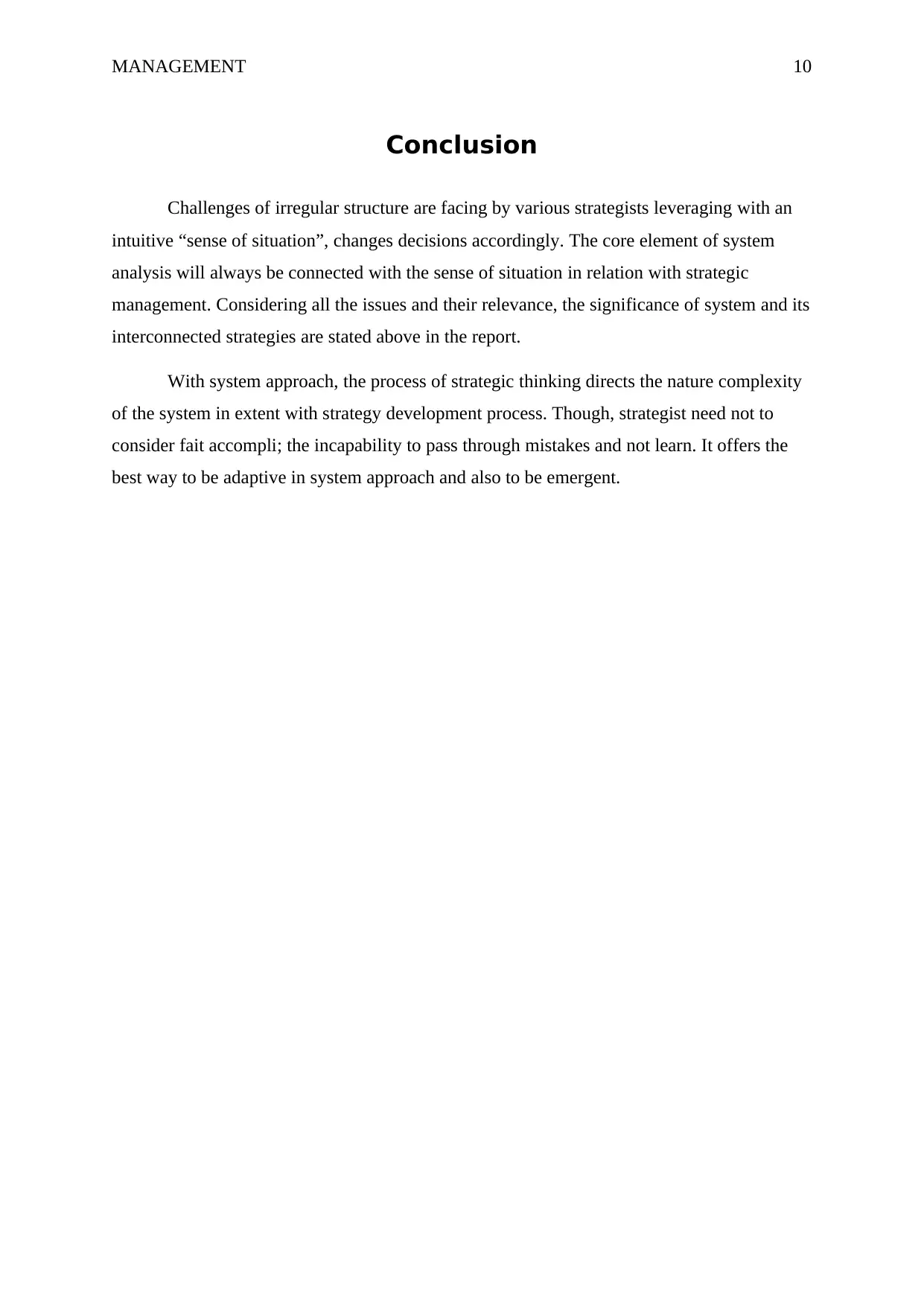
MANAGEMENT 10
Conclusion
Challenges of irregular structure are facing by various strategists leveraging with an
intuitive “sense of situation”, changes decisions accordingly. The core element of system
analysis will always be connected with the sense of situation in relation with strategic
management. Considering all the issues and their relevance, the significance of system and its
interconnected strategies are stated above in the report.
With system approach, the process of strategic thinking directs the nature complexity
of the system in extent with strategy development process. Though, strategist need not to
consider fait accompli; the incapability to pass through mistakes and not learn. It offers the
best way to be adaptive in system approach and also to be emergent.
Conclusion
Challenges of irregular structure are facing by various strategists leveraging with an
intuitive “sense of situation”, changes decisions accordingly. The core element of system
analysis will always be connected with the sense of situation in relation with strategic
management. Considering all the issues and their relevance, the significance of system and its
interconnected strategies are stated above in the report.
With system approach, the process of strategic thinking directs the nature complexity
of the system in extent with strategy development process. Though, strategist need not to
consider fait accompli; the incapability to pass through mistakes and not learn. It offers the
best way to be adaptive in system approach and also to be emergent.
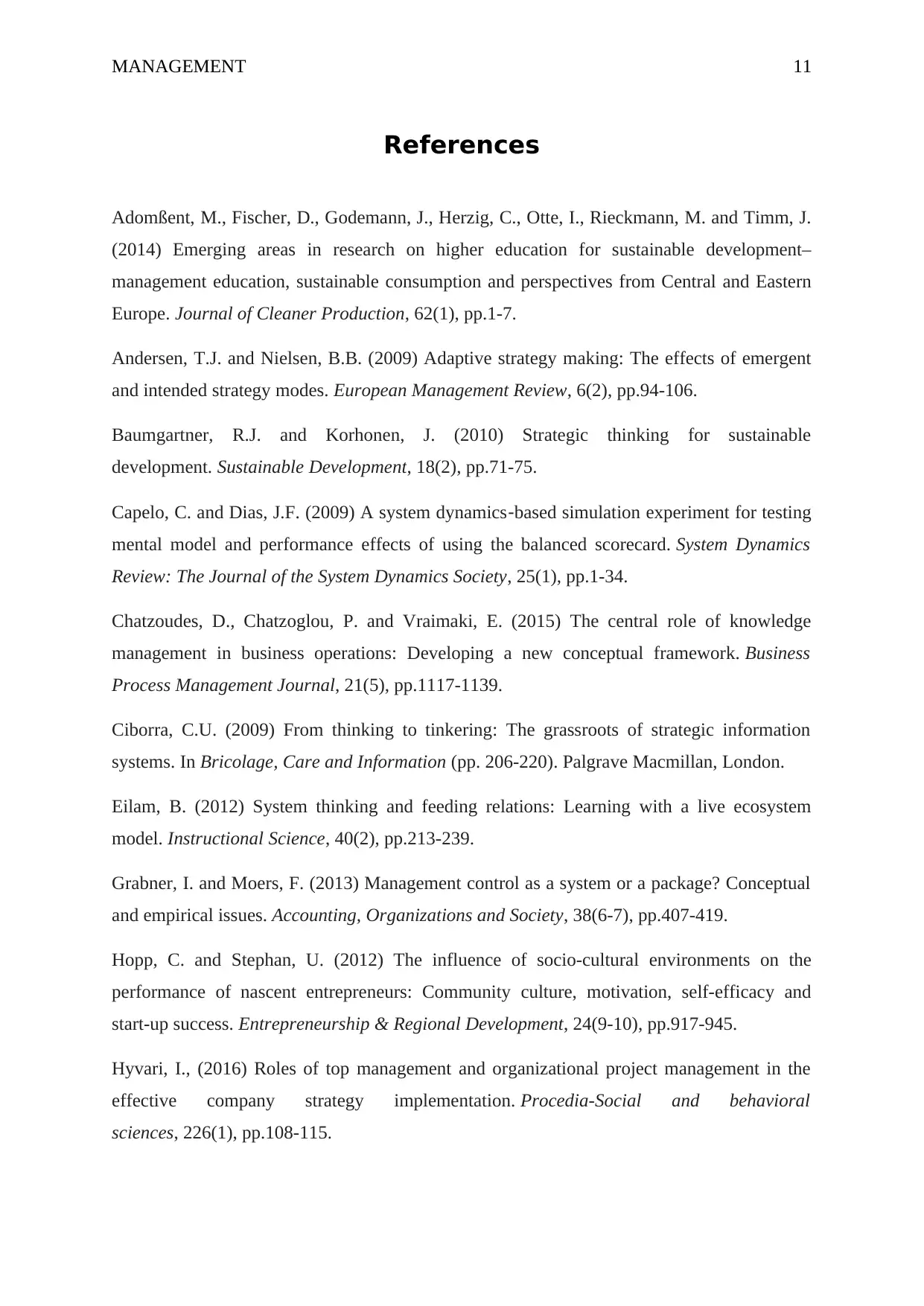
MANAGEMENT 11
References
Adomßent, M., Fischer, D., Godemann, J., Herzig, C., Otte, I., Rieckmann, M. and Timm, J.
(2014) Emerging areas in research on higher education for sustainable development–
management education, sustainable consumption and perspectives from Central and Eastern
Europe. Journal of Cleaner Production, 62(1), pp.1-7.
Andersen, T.J. and Nielsen, B.B. (2009) Adaptive strategy making: The effects of emergent
and intended strategy modes. European Management Review, 6(2), pp.94-106.
Baumgartner, R.J. and Korhonen, J. (2010) Strategic thinking for sustainable
development. Sustainable Development, 18(2), pp.71-75.
Capelo, C. and Dias, J.F. (2009) A system dynamics‐based simulation experiment for testing
mental model and performance effects of using the balanced scorecard. System Dynamics
Review: The Journal of the System Dynamics Society, 25(1), pp.1-34.
Chatzoudes, D., Chatzoglou, P. and Vraimaki, E. (2015) The central role of knowledge
management in business operations: Developing a new conceptual framework. Business
Process Management Journal, 21(5), pp.1117-1139.
Ciborra, C.U. (2009) From thinking to tinkering: The grassroots of strategic information
systems. In Bricolage, Care and Information (pp. 206-220). Palgrave Macmillan, London.
Eilam, B. (2012) System thinking and feeding relations: Learning with a live ecosystem
model. Instructional Science, 40(2), pp.213-239.
Grabner, I. and Moers, F. (2013) Management control as a system or a package? Conceptual
and empirical issues. Accounting, Organizations and Society, 38(6-7), pp.407-419.
Hopp, C. and Stephan, U. (2012) The influence of socio-cultural environments on the
performance of nascent entrepreneurs: Community culture, motivation, self-efficacy and
start-up success. Entrepreneurship & Regional Development, 24(9-10), pp.917-945.
Hyvari, I., (2016) Roles of top management and organizational project management in the
effective company strategy implementation. Procedia-Social and behavioral
sciences, 226(1), pp.108-115.
References
Adomßent, M., Fischer, D., Godemann, J., Herzig, C., Otte, I., Rieckmann, M. and Timm, J.
(2014) Emerging areas in research on higher education for sustainable development–
management education, sustainable consumption and perspectives from Central and Eastern
Europe. Journal of Cleaner Production, 62(1), pp.1-7.
Andersen, T.J. and Nielsen, B.B. (2009) Adaptive strategy making: The effects of emergent
and intended strategy modes. European Management Review, 6(2), pp.94-106.
Baumgartner, R.J. and Korhonen, J. (2010) Strategic thinking for sustainable
development. Sustainable Development, 18(2), pp.71-75.
Capelo, C. and Dias, J.F. (2009) A system dynamics‐based simulation experiment for testing
mental model and performance effects of using the balanced scorecard. System Dynamics
Review: The Journal of the System Dynamics Society, 25(1), pp.1-34.
Chatzoudes, D., Chatzoglou, P. and Vraimaki, E. (2015) The central role of knowledge
management in business operations: Developing a new conceptual framework. Business
Process Management Journal, 21(5), pp.1117-1139.
Ciborra, C.U. (2009) From thinking to tinkering: The grassroots of strategic information
systems. In Bricolage, Care and Information (pp. 206-220). Palgrave Macmillan, London.
Eilam, B. (2012) System thinking and feeding relations: Learning with a live ecosystem
model. Instructional Science, 40(2), pp.213-239.
Grabner, I. and Moers, F. (2013) Management control as a system or a package? Conceptual
and empirical issues. Accounting, Organizations and Society, 38(6-7), pp.407-419.
Hopp, C. and Stephan, U. (2012) The influence of socio-cultural environments on the
performance of nascent entrepreneurs: Community culture, motivation, self-efficacy and
start-up success. Entrepreneurship & Regional Development, 24(9-10), pp.917-945.
Hyvari, I., (2016) Roles of top management and organizational project management in the
effective company strategy implementation. Procedia-Social and behavioral
sciences, 226(1), pp.108-115.
⊘ This is a preview!⊘
Do you want full access?
Subscribe today to unlock all pages.

Trusted by 1+ million students worldwide
1 out of 13
Related Documents
Your All-in-One AI-Powered Toolkit for Academic Success.
+13062052269
info@desklib.com
Available 24*7 on WhatsApp / Email
![[object Object]](/_next/static/media/star-bottom.7253800d.svg)
Unlock your academic potential
Copyright © 2020–2025 A2Z Services. All Rights Reserved. Developed and managed by ZUCOL.




